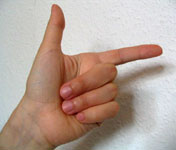Radical 12
| 八 | ||
|---|---|---|
| 11 ⼊ ◄ | 12 | ► ⼌ 13 |
| Pinyin : | bā 倒 八字 dàobāzì (= inverted eight) 羊角 yángjiǎo (= goat horns) |
|
| Zhuyin : | ㄅ ㄚ | |
| Hiragana : | は ち が し ら hachigashira | |
| Kanji : | 八 頭 hachigashira | |
| Hangul : | 여덟 yeodeol | |
| Sinocorean : | 팔 pal | |
| Codepoint : | U + 516B |
|
| Stroke sequence : |
|
|
The radical 12 , meaning " eight ", is one of 23 traditional radicals in Chinese writing that are written with two strokes.
With 11 character combinations in Mathews' Chinese-English Dictionary , it is relatively rare. In the Kangxi dictionary there are 44 combinations of characters under this radical.
As a radical, 八 can also appear upside down, as in the sign 羊 (= goat).
The symbol indicates a division into two, because the eight can be divided into two equal halves. The radical is often shortened to two drops or dots in the upper part of the character. “Divide, separate” is also the name of the sign when the figure eight still includes the radical 18刀 (= knife).
The original meaning was "separate". Only later was 八 used as a loan symbol for the number eight. The character 八 is also used as a sound carrier, for example in 扒 (= hold on).
The sign is similar to the katakana sign ハ "ha".
Character compounds ruled by radical 12
| Strokes | character |
|---|---|
| + 0 | 八
|
| + 2 | 公 六 兮 兯
|
| + 3 | 兰
|
| + 4 | 共 兲 关 兴
|
| + 5 | 兵
|
| + 6 | 其 具 典
|
| + 7 | 兹 兺 养
|
| + 8 | 兼
|
| + 9 | 兽
|
| +11 | 兾 兿
|
| +14 | 冀
|
| +16 | 冁 |
In the Unicode block Kangxi radicals , radical 12 is coded under the code point number 12.043 (U + 2F0B).
literature
- Edoardo Fazzioli : Painted Words. 214 Chinese characters - from picture to concept . Marixverlag, Wiesbaden 2004, ISBN 3-937715-34-7 , p. 238 .
- For detailed references, see List of Traditional Radicals: Literature
Web links
- Xiù cai.oai.de (PDF; 1.72 MB) Explanation of radical 12 on page 10

